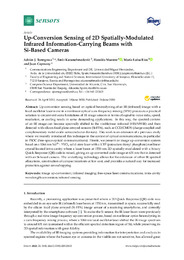Por favor, use este identificador para citar o enlazar este ítem:
https://hdl.handle.net/11000/34770Registro completo de metadatos
| Campo DC | Valor | Lengua/Idioma |
|---|---|---|
| dc.contributor.author | Maestre, Haroldo | - |
| dc.contributor.author | Torregrosa, Adrian J. | - |
| dc.contributor.author | Karamehmedovic, Emir | - |
| dc.contributor.author | Rico Soliveres, María Luisa | - |
| dc.contributor.author | Campany, Juan | - |
| dc.contributor.other | Departamentos de la UMH::Ingeniería de Comunicaciones | es_ES |
| dc.date.accessioned | 2025-01-17T08:17:28Z | - |
| dc.date.available | 2025-01-17T08:17:28Z | - |
| dc.date.created | 2020 | - |
| dc.identifier.citation | Sensors | es_ES |
| dc.identifier.issn | 1424-8220 | - |
| dc.identifier.uri | https://hdl.handle.net/11000/34770 | - |
| dc.description.abstract | Up-conversion sensing based on optical heterodyning of an IR (infrared) image with a local oscillator laser wave in a nonlinear optical sum-frequency mixing (SFM) process is a practical solution to circumvent some limitations of IR image sensors in terms of signal-to-noise ratio, speed, resolution, or cooling needs in some demanding applications. In this way, the spectral content of an IR image can become spectrally shifted to the visible/near infrared (VIS/NWIR) and then detected with silicon focal plane arrayed sensors (Si-FPA), such as CCD/CMOS (charge-coupled and complementary metal-oxide-semiconductor devices). This work is an extension of a previous study where we recently introduced this technique in the context of optical communications, in particular in FSOC (free-space optical communications). Herein, we present an image up-conversion system based on a 1064 nm Nd3+: YVO4 solid-state laser with a KTP (potassium titanyl phosphate) nonlinear crystal located intra-cavity where a laser beam at 1550 nm 2D spatially-modulated with a binary Quick Response (QR) code is mixed, giving an up-converted code image at 631 nm that is detected with an Si-based camera. The underlying technology allows for the extension of other IR spectral allocations, construction of compact receivers at low cost, and provides a natural way for increased protection against eavesdropping. | es_ES |
| dc.format | application/pdf | es_ES |
| dc.format.extent | 15 | es_ES |
| dc.language.iso | eng | es_ES |
| dc.publisher | MDPI | es_ES |
| dc.relation.ispartofseries | 20 | es_ES |
| dc.relation.ispartofseries | 12 | es_ES |
| dc.rights | info:eu-repo/semantics/openAccess | es_ES |
| dc.rights | Attribution-NonCommercial-NoDerivatives 4.0 Internacional | * |
| dc.rights.uri | http://creativecommons.org/licenses/by-nc-nd/4.0/ | * |
| dc.subject | image up-conversion | es_ES |
| dc.subject | infrared imaging | es_ES |
| dc.subject | free-space laser communications | es_ES |
| dc.subject | intra-cavity wavelength conversion | es_ES |
| dc.subject | infrared sensing | es_ES |
| dc.subject.other | CDU::6 - Ciencias aplicadas::62 - Ingeniería. Tecnología | es_ES |
| dc.title | Up-Conversion Sensing of 2D Spatially-Modulated Infrared Information-Carrying Beams with Si-Based Cameras | es_ES |
| dc.type | info:eu-repo/semantics/article | es_ES |
| dc.relation.publisherversion | https://doi.org/10.3390/s20123610 | es_ES |

Ver/Abrir:
2 - sensors-20-03610-v2.pdf
4,63 MB
Adobe PDF
Compartir:
 La licencia se describe como: Atribución-NonComercial-NoDerivada 4.0 Internacional.
La licencia se describe como: Atribución-NonComercial-NoDerivada 4.0 Internacional.
.png)